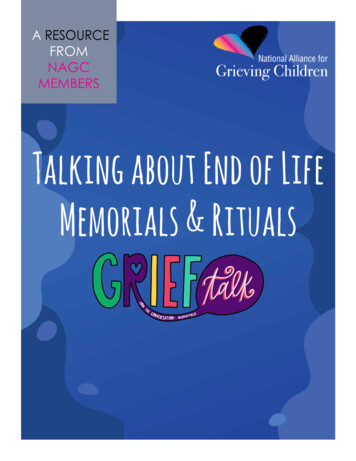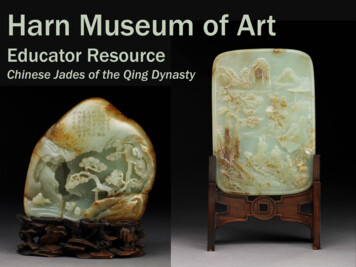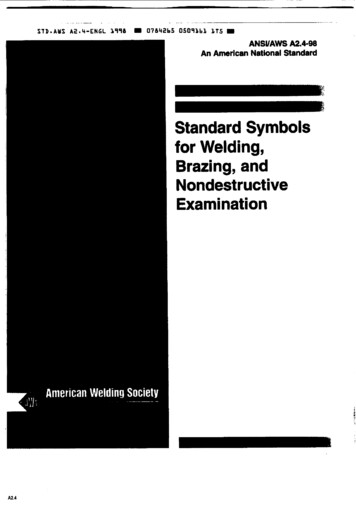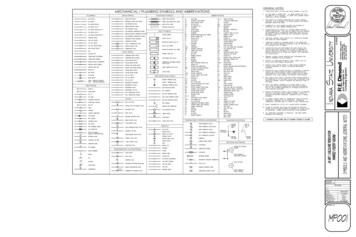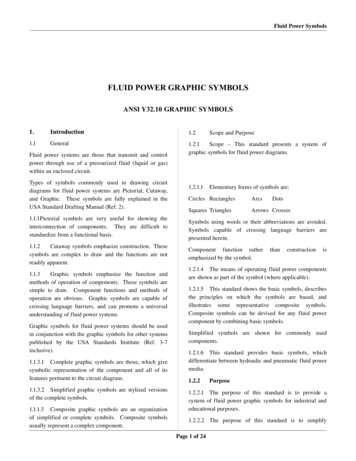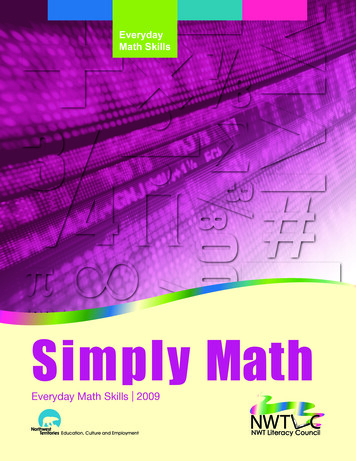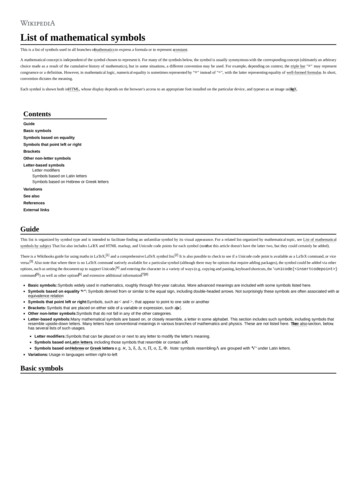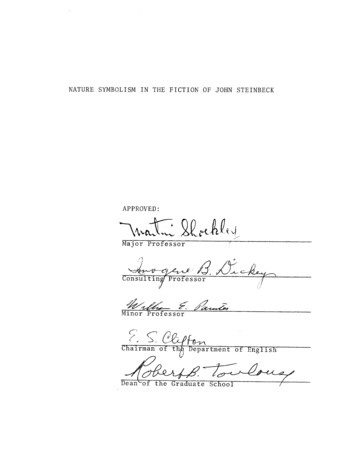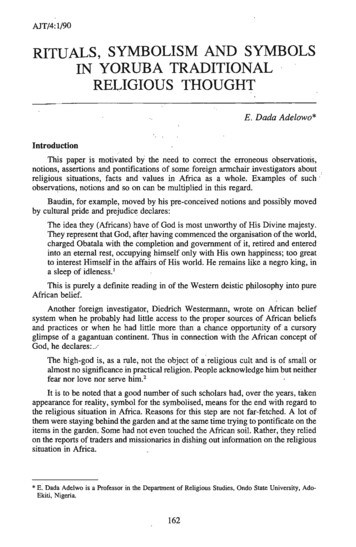
Transcription
AJT/4:l/90RITUALS, SYMBOLISM AND SYMBOLSIN YORUBA TRADITIONALRELIGIOUS THOUGHTE. Dada Adelowo*IntroductionThis paper' is moti ated by 'the need . to ' correct the erroneOUS observatiods,notions, assertions and pontifications of some foreign armchair investigators about .religious situations, facts and values in Africa as a whole. Examples of such 'observ tions, notions and so on can be multiplied in this regard.Baudin, for example, moved by his pre-conceived notions and possibly movedby cultural pride and prejudice declares:The idea they (Africans) have of God is most unworthy of His Divine majesty.They represent that God, aft rhaving commenced the organisation of the world,charged Obatala with the completion and government of it, retired and enteredinto an eternal rest, occupying himself only with His own happiness; too greatto interest Himself in the affairs of His world. He remains like a negro king, ina sleep of idleness. 1This is purely a definite reading in of the Western deistic philosophy into pureAfrican belief. .Another foreign investigator, Diedrich Westermann, wrote on African beliefsystem when he probably had little access to the proper sources of African beliefsand practices or when he had little more than ' a chance opportunity of a cursoryglimpse of a gagantuancontinent. Thus in connection with the African concept ofGod, he declares: JThe high-god is, as a rule, not the object of a'religious cult and is of small oralmost no significance in practical religion. People acknowledge him but neitherfear nor love nor serve him. 2It is to be noted that a good number of such scholars had, over the years, takenappearance for reality, symbol for the symbolised, means for the end with regard tothe religious situation in Africa. Reasons for this step are not far-fetched. A lot ofthem were staying behind the garden and at the same time trying to pontificate on theitems in the garden. Some had not even touched the African soil. Rather, they reliedon the reports of traders and missionaries in dishing out information on the religioussituation in Africa.* E. Dada Adelwo is a Professor in the Department of Religious Studies, Ondo State University, AdoEkiti, Nigeria.162
AJT/4:1/90Thus, ,the need is felt to present the topic - rituals, symbolism and symbolswhich are sure sources of African beliefs and practices -'-- as a means to intimate thecursory observers about what, in fact, constitutes the actual religious situations inAfrica and in Yorubaland in particular.Rituals and Rites: An Issue of FunctionalityRituals and rites are a means of bringing into the limelight the eligio s experience .ofa group of people; Rituals and rites thus constitute some kind of religiousexpression. They are a means of concretising one's belief system. They are a meansof expressing one's experience of the supersensible world and the supernaturalbeings. In short and simple terms, they are acts of forms of worship or communionand communication between one and one's objects of worship.Before w begin an analysis of the types of rituals and rites, let us have a lookat t e following basic items:Ritual Leaders·Rituals in Yoruba traditional religion are not usually administered by theuninitiated or the untrained (Yoruba: ogberi) , Rituals are usually administered by thepriests known as aworo or iworo. They are specialists in leading the others inworship. They are devotees of orisa; that is, there is something of the divinity in themand it belongs to their position not only that they should offer worship to the orisa,but also that they shollld absorb the orisa into their being and manifest it. Traditionally,specialists in ritual administration followed the craft from father to sOIl; throughseveral or even many generations, handing down their techniques and forms oftraining, their quintessential experience and habitual shrines where application collldbe made to the gods and spiritS.It is to be noted that it was an attempt to resolve. the need for an adequate linkbetween the object of worship arid man that the idea of ritual leaders . emerged inYoruba religious thought And since man felt that heha,d to deal not wilh a vagueabstraction but a Reality with the attributes of person, he naturally t1i Ught of .means which would be a person - a person sufficiently "human" to make intimatecontact with man and not harm him. In short, the need for a personal mediator, apriest, a ritual leader, a specialist in ritual administration, arose. 4.In the cultic activities of a town the Oba is usually the head of the ritual leaders.He is the priest-king. In He-Ife, for example, the Ooni of Ife, Aldse EkejiOrisa isusually the Pointifex Maximus, He is the 016rf Awon [woro -:- the head 'ofall thepriests. He assumes this office in consequence of his sceptre (are) which is derivedfrom the divinity to whom he is vicegerent. The office still stands even though .theOoni does not now officiate directly at any particular shrine and only performscertain customary rituiils as tradition decrees.Ritual Power. The Ooni of Ife or any head of Yoruba town is mentioned above as the head ofall priests. This is in consequence of the ritual power believed to be possessed by the.kings or rulers. Yoruba kings are believed to be derivatively divine '-They are heldto be second-in-command to the Divinity - Aldse Ekeji Orisa. That is, Kings in163
AJT/4:1/90Yorubaland are divine. But according to Basil Davidson, 'ritual's would be abetteradjective. Kings in Yorubaland are frrst and .foremost repositories of ritual power.Their authority rests mainly and consistently upon its place in their people's beliefsabout themselves and the world. Yoruba kings are ritual specialists who haveaccumulated power in societies which have passed beyond the early subsistencelevel and had developed whether in isolation or by the stimulus of migrant ---,resident accommodation, the need as well as the possibility of centralising institutions .Thus the original nature.'of Yoruba kings is to be sought in ritual specialismassociated with the guardianship of ancestral charters.It is to be noted that Yoruba kings, then, were not 'divine' in the sense of beingregarded as gods. They are political and therefore earthly people as well as ritual andhence spiritual ones.Hence the accent on 'divinity'. For the king's existence as a political figure ormilitary leader is a secondary thing. Over and beyond these secular functions, aYoruba Oba has to maintain harmony and concord between society and its naturalenvironment by means of ritual action of a regular kind which he alone could take.His functions in this realm are three-fold: to perform the daily rites 6 for which he isuniquely qualified by office; to provide for and direct the activities of other cults; andto sustain and control his own spiritual potency. These words about the kingship ofthe Nigerian Jukun have a wide application and are relevant to the picture givenabove. Block of medieval Western Europe writes:The king . (had) three fundamental duties and scarcely any other to ensure thespiritual welfare of his people by acts of piety and the protection given by actsof piety and the protection given by the true faith; to defend his people againstoutside enemies . , and at home, to safeguard justice andpeace.!.Other priests, Yoruba [woro, Aworo, Abore have ritual power in consequence ofthepCJwet bestowed on the priest - king, 0l6rf [woro. Thus the ritual power ofpriests is subsumed in thepo er of the priest-king, a priest never functions inconnection with the central cult and culture without the knowledge and courtesy ofthe priest-king.Ritual SanctityThis has to do with the various taboo in connection with the administration ofthe various rituals and rites that constitute Yoruba traditional religion. This can alsobe called ritual holiness. The taboo are what the Yorubacall eewo, a kU see, ohun.Each ritllal has its taboo that should be avoided by the priest-king, Ol6rf dwon [woro,other priests, [woro or Abore, and the worshippers. For examples the priests anddevotees of the god called Esu should avoid having any contact with palmnut oil(Yoruba: adi) in order not to incur the wrath of Esu. Moreover, the priests anddevotees of the arch-divinity of Yoruba pantheon, ObatdlO,1 should avoid palmwinecompletely in order to maintain ritual sanctity with regard to the worship of Obdtdld.They should also promote anything white and avoid black items in order to keep theritUal sanctity in connection with the worship of the divinity. ·White is a symbol ofpurity, holiness and peace. So, priests and devotees of Obdtdld should, during ritualactivities, present themselves as 'pure and holy.164
AJT/4:1/90The point here is that ritual items should be done according to the prescriptionsof the object of worship in order to have the desired result. In this connection theYoruba declare:E je ka see,m won ti i see,K' 0 le baa d,BI se e rl.Let us do it,The way it is usually done,So that we may have the usual result.Rituals and Rites in Yoruba Religion:Some ExamplesRituals and rites abound in Yoruba traditional religion. A brid survey would beattempted here.Let us start with the ritual in connection with the worship of God - Olodumareand gods - Orisa. There is a specific cult of Olodumare in Y orubaland. This maybaffle those foreign arm-chair investigators who hold the thesis that Olodumare isnot an object of worship in Yoruba religion. The point here is .because 016dumarecannot be confined into space (theYoruba described Him as A-te-rere-K'aye - Onewho occupies the whole extent of the world); the ritualistic worship offered to Himtakes place in the open and not in building like temples and mosques. The worshippermakes a circle of ashes (Yoruba: eeru) or white chalk (Yoruba: efun); within thecircle, which is a symbol of eternity, he pours a libation of cold water, and in thecentre he places his kolanut (Yoruba: obi on cotton wool- Yoruba: owu etUtu). Hethen takes the kolanut, splits it and holding the valves within the circle. Often, a.whitefowl (Yoruba: adiefunfun) is offered in the same way. In lle-Ife, the ancestralhome of the Yoruba, there is a priest-chief whose duty is to offer this ritual everymorning in the name of the Doni and of all the people. However, it is unfortunate tonote that the direct ritualistic worshIp of 0l6dumare, as a regular aspect of culticactivities in Yorubaland, is dying out. In some places, according to Bolaji Idowu, itis no longer known; in some, it haS become the cult of women. 8Next is daily worship of the gods. The daily morning worship is simple andusually private in that it is usually the activity of one person. For this simple worship,the worshipper provides himself with water and kolanuts. The worshipper standsbefore the shrine (Yoruba: ojubo orisa) and begins the worShip with the invocationwherein he calls the orisa by his names and appelationsand invites him to giveattention to his "child".9 During the invocation a rattle may be sounded to attract theattention of the divinity, and the libation (Yoruba: hutu) is poured either on theground or on the shrine. The worshipper then gives the reason for invoking the Orisa:After this, the kolanut lO is split, and now comes an anxious moment, for the worshipperexpects by the omen 11 of the kolanut to know whether his worship has been accepted(Yoruba: ebo fUn, ebo gba) or rejected.Others, are on sacred days of the orisa and on'annual festivals in honour of thetutelary divinities. On the sacred day of the orisa, worship is more elaborate andusually involves a community of worshippers. The actual ritual follows practically165
AJT/4:l/90the' same pattern as the daily one, but there are important details which give it itsdistinction. Worshippers are dressed up for the occasion, and there are gifts of food ,and drink and payment of vows (Yoruba: eje sfsan) taken to the orisa. There must beas many kolanuts as there are worshippers, and even additional ones for those whofor some reason are not presented. Worshippers are presented severally to On'sa.Then we have the ritual during the annual festivals. The main difference betweenworship on the sacred day and worship during the annual festival. is the moreelaborate programme connected with annual celebrations.This is usually an occasion for jocundity and thanksgiving; people appear intheir best and give of their best. The offerings are mostly thank-offerings, -and themeals constitute an opportunity of communion between the divinity and his "children"on the one hand, and then among the "children themselves on the other. It is a periodfor special rene\yal of covenant relationships. On such occasion, the head of thecommunity, the priest-king, the PontifexMaximus, is usually involved. It is he whois ultimately responsible for all that happens during the,festival. He also has a specialritual, which, personally or by proxy, he must perform during each festival.Next are rituals and rites in connection with the various sacrifices.12 'Here, onlya few examples would be considered. According to Bolaji Idowu, sacrifice is of theessence of Yoruba religion as it is of every religion the world has ever knownY Insacrifice, the ,Yoruba' offers almost all kinds of foods and drinks 'and all ·kinds ofliving things. In theory, all sacrifices belong entirely to the divinities. But in practice,worshippers often partake of them, particularly of things which can be eaten.The highest type of sacrifice among the Y oruba used to be human sacrifice. Thevictim of human sacrifice was usually made to bless the people in some prescribedway which bore upon the occasion of sacrifice. He was then given a special messagewhich he was to deliver on arrival in the presence of the Deity or the divinities. Incertain cases, a .humaq who was sacrificed was more than just a victim offered toappease the divinities. He was believed to be going to represent the people before,and convey the petitions to, the higher power. The basic point here is that somebodyor. something must be given out so that others may live and be blessed. 14 Others,given to either God or gods, include meal and ,drink offerings which usually beginwith the customary libations, Gift or Thank-offering, offered to orisa in appreciationof some success, Votive offering (Yoruba: .ebo eje) given to fulfil the promise madewhen one begs for certain favours that are eventually effected. Next is Propitiation(Yoruba: Ebo Etutu) - sacrifice of appeasement. This is usually prescribed by theoracle or an orisa in reply to an inquiry as to what can be done to save the situationduring a crisis like epidemic,drought, famine, serious ailment and so on. Then wehave Substitutionary (Y oruba: A -ye-ipfn-ohUn) -'- "That which alters an agreement".This is usually given to foil an agreement among the emere children (wanderingspirits ofchildren given to the prank of entering into pregnant women on being bornonly to die for the sheer relish of mischief). There is the one called Preventive (Yoruba: Ogunkoja)- The offering here which may be meal or drinks wards offevil. At times the oracles or the priests may prescribe, for example, that each personin the comml\nity should rub his body all over with an article - a Nigerian kobo ora head of maize for example - and drop it at a given place for which allbecollected and disposed of according to the Particular ritual for the occasion.will166
AJT/4:1/90Then we have rites in connection with the enthronement or coronation of a king.Here'the coronation of the AlaiUin of Oyo would be discussed. Rituals in connectionwith the coronation include the::following:i)partaking of the dish prepared from the heart of the late king which has beenextracted and preserved. After partaking of this, he is told he has "eaten .theking". Hence the origin of the phrase je oba, to become a king (lit to eat aking)ii) 'At a place called 'Bara', he worships at the tombs of his fathers; a horse, acow and a ram are being offered at each tomb.iil) On the fifth day, he goes to Koso, the shrine of Sang6, the third AlaiUin ofOyo and the god of thunder and lightning, for actual crowning.iv) After another interval of five days,he goes to the shrine of Oranyan. Herethe Great Sword (Yoruba: Ida Nltl) or Sword of Justice (Yoruba: Ida Idaj6Ododo) brought from TIe-Ife is pla:ced in his hands, without which he canhave no authority to order an execution.After another interval of five days, he goes to the shrine of Ogun, god of iron andwar, and there offers a propitiatory sacrifice for a peaceful tenure. The offeringsconsist of a cow, a rilm, and a dog; dog being indispensable in any sacrifice to the godof war. 16From the shrine of Ogun, the procession goes straight onto the palace, enteringnow for the first time by the main gate opened for him. Thus he enters the palaceproper as the king after the necessarx ritUals had been completed. .There are also ritUals which belong to the secret societies such as the Egungunand Ora, (OsugbO) guilds, and ,the Ogboni cults The members of these groups makeon exclusive claim for the possession of knowledge of the mysteries of their cults andfor the right to perform the ceremonies which are jealously guarded from the view ofthe uninitiated. The members are initiated into the cult through certain rituals whichare administered surreptitiously. Thus. the name "secret societies". It is insiders, andnot otherwise, that can know details about the rituals of these groups. One importantpoint that should be noted here is that the societies are both religious and political insome cases. In this connection, J.O. Lucas, in connection with Ora guild, remarks:. rhe guild possesses great political power. In the days of the independence ofAbeokuta, members of the guild formed the majority in the political councilknown as the Ogboni council. 17.The important point to note here is the synthesis of religion and politics intraditional Yorubaland;Lots and lots of death and funeral rites and rituals abound in Yorubaland. Someof these rites and rituals f1T ordipary ,while some are special.In Yoruba traditional practice, immediately a person dies, the first rite is to slaya fowl known as adie iranii 18 - ''The fare fowl". This is meant to make the road easyfor the deceased.Next is food for the deceased. in the Yoruba traditional system, when the corpseis laid in state, a yam meal is prepared and portion of it is placed at the foot of the167
AJT/4:1/90bier. The following are given special burial rites in Yoruba: king (Yoruba; Oba),19albino (Yoruba: affn), leper (Yoruba: adete), one with hunched back (Yoruba:abuke), pregnant mother (Yoruba: aboyun, abara meji), one who hangs himself(Yomba: eni tf 6 pa okun so), and bom-to-die-children (Yoruba: iLbfku, emere).There are some funeral rituals that are peculiar only ,to Yoruba religion. Forexample, in Yoruba funeral practice, when the corpse is lowered to the grave, the ·survivors draw near it, each according to the status of his family and each bringingan animal victim, usually a goat; he offers his gift through the officiating minister,asking that the deceased should accept it, and praying not to sleep in the worldbeyond, but to open his eyes wide and always look after his children The point herehas to do with the belief of the Yoruba that .death is not the end of life. It is only amedium whereby the present earthly existence is changed for another.Other peculiar items include RIM aku ya hun - "Entering into a covenant withthe deceased"andfifa Eegun aku iuo' le - "Bringing the spirit of the deceased intothe house. By this, it is believed, the surviving children and relations will be able tohave close connection with the deceased. The ritual usually takes place at night whenall lights have peen put out. In this connection, a shrine is made in one corner or atthe bottom of the control wall of the house; this is a specific meeting place betweenthe deceased and the children.Symbolism and SymbolsSymbolism, symbology and symbols have t{} do with a study in representationalarts in Fine Art and Religion. Symbols'could be regarded as signs, marks or objectslooked upon as representing something or relaying certain message about one thingor the other.The Yoruba, to avoid casting their minds on abstract entitit s during worship,resort to using symbols or emblems with a view to concretising their worship.The Y oruba symbolise a lot of items in their. expression of their religiousexperience. Let us start by examining therepresentations they have given to theirtutelary deities and ancestors.The Yoruba used wood2 and metal21 carvings, plan'ts and animals as symbols ofgods and ancestral spirits. Before we go further, iris important to note that, as saidearlier, these symbols are not ends in themselves but means to certain ends. Thusthose who are out to conduct a genuine research into the religious situation inYorubaland should not take appearance for reality, means for an end, symbol for thesymbolised and reality for shadow . Divinities and ancestors are sure objects of worship and reverence among theYoruba. However, it is to be noted that they are a means to get to Olodumare - God,the ultimate End of everything. The Yoruba 'have never made the mistake of puttingGod, Olodumare, on the same pedestal with the divinities (arisa) and the ancestors.In their belief, 0l6dillnare is unique, incomparable. The.uniqueness of Olodumare isone reason why there are no images-graven or in drawing or in painting - of Himin Yorubaland. Symbols there are copious, but no images of Him. Symbols or imagesof deities or divinities abound in Yorubaland. OrisiL'nlti, the arch-divinity ofYorubapantheon is usually pictured as an ancient figureiri white and bedecked with white168
AJT/4:l/90ornaments. His temple, especially the inside, is washed white, his emblems are to bekept in white containers and consists, among other things, of white chalk and whitebeads. His priests and priestesses are robed in white and wear white ornaments.Those who do not understand the religion ofthe Yoruba might think that the itemsare the things that matter here. This is patently wrong. The message here is that allthose white items point to Orisa- 'nla as presenting, to the Yoruba, the idea of ritualand ethical purity, and therefore the demands and sanctions of high moral pattern.The white items are mere symbols symbolising purity, holiness, cleanliness on thepart of the ritual leaders and the worshippers of Orisa- 'nla.Ifa, as a system of divination, is a symbol of wisdom in connection with theoracle divinity called Orunmila.In this connection Wande Abimbola says:Ifa, otherwise known as Orunmila is the Yoruba god of wisdom; one of thepraise-names of Orunmila isakere{inusogb6n (the small one with a mind fullof wisdom).22.The concrete items such as apeie (16 beads), ikin (16 nuts), ir6ke (the tapper),op6n ifa (Ifa tray or bowl which is used in divining is only a symbol symbolisingOrunmila, the god of divination, the god of wisdom and omniscience, as a wise god.Lucas is of the opinion that cosmological ideas are associated with the headscarved on Ifa trays. They represent, according to the traditional beliefs, and confIrmedby my informants,23 the four divinities presiding over the four corners of the worldand whose domains are the four chief Odii of Ifa viz:Ogbe, Oyeku, Iwari and OdfThe Odus are generally arranged to form the four points of the compass. 24 Theorientation is as follows:OdimejiEji OgbeIwon MejiThe points of the compass represented and the gods presiding over the respectivecorners are as follows:Eji-OgbiEastEsu2. Oyeku MejiWestSang61.3,Iwon MejiSouthObatruci4.OdiiMejiNorthOgun.Here we see the Odiias symbols of compass direction and particular divinities.Ogun, god of war, god of iron, is usually represented by iron. Among the Yoruba,there exists a traditional connection between Sango - the god of thunder andlightning, and Ogun; the thunder-axe is used in the cult worship of Sang6 as well as169
AJT/4:1/90of Ogun. The point here is that the iron-axe, which is usually a tough instrument,points to Sango and Ogun as gods of war, gods that should be feared and respected.Among the Yoruba, wrought-iron staffs are used in a number of cults, withparticular motifs associated with particular cults. For example, the iron staffs forOsanyin, the god associated with traditional medicine, have sixteen birds in a circlearound a central bird. The sixteen birds represent the sixteen basic signs of the Ifaoracle 25 which provide a system of classification for all medicinal ingredients.Edan, a pair of figures, one male and one female, is a symbol of initiation intothe OgbOni fraternity. The pair of figure is usually joined by a chain. They are usedin OgbOni ritual, and every member of the Ogboni society has a pair of these figures,made for his initiation into the society.Some symbols are made to identify one divinity or the other. For use intraditional religion, Yoruba sculptors made human and animals figures, ornamentalbowls, drinks, stools, spears, masks and so on. The god for whom th object is madecan be identified by the symbols or emblems and motifs used. Sango, the god ofthunder and lightning, priest of the rainrnakers of Yorubaland and identified as oneof the earliest kings ·of the Oyo kingdom, has been mentioned in connection withritual pottery, but his shrines also contain a good number of wood .carvings. They .arevariable art galleries containing a good variety of wooden dance staffs, ese Sango,decorated with the double headed axe 26 emblem and human figures, inverted mortars,odo Sango, decorated with devotees and the emblems of the god and carved figuresholding a bowl, arugM, the last two storing the thunder - bolts; (edun aara instruments to effect justice).The Yoruba holds the global record for twin births. Visits to .a diviner andspecial rites are necessary when twins are born. Wooden figures, ere ibeji, are carvedas substitutes for the twins if one or both of them should die, to ensure the continuedfertility of the mother And the health of any surviving twin. The ere ibeji are ritually ·washed, dressed, decorated and fed, and the mother would keep the carving at homeon the family twin altar, in her sleeping room where the carving is often wrapped forsleep, or in a container.There are certain actions of the Yoruba that are usually religiously symbolic.Burning of the born-to-die children symbolises displeasure with that type of children.It is also a way of dissuading such children from repeating their terrible itinerary.In Yoruba traditional medicine, symbols occupy a very significant place. Thetraditional herbalists make use of plants, roots, and animal species in the preparationof medicine for healing purposes, and such materials, have, by oral tradition, beenstudied and believed to be effectual.Symbolism is taken into serious consi eration in the collection, preparation andapplication of the prepared medicine. The herbalist is supposed to know the best timeto collect leaves and plants, or bark of stems and may have to recite some incantations27before or after collecting them. Mircea Eliade calls such enactrnents' symbolism ofmythical precedents'.28 E.G. Parrinder rightly observes that:It is not easy to find out why certain remedies are used fancied resemblance to the symptoms of the disease. 29170they may have some
AJT/4:l/90Another category of symbols I would like to bring to your notice is in connectionwith some deities that point to some of the attributes of God - 0l6dumare. Sdng6and Sonponnd for example are conceptualisations of the wrath of God while Orisd 'nlaor Obdtdld is described by some of Yoruba elders as the image or symbol of0l6dumare on earth. Yoruba theology also refers to Orisanl'n as the offspring of016dumare inthe sense that he derived immediately from Him and that the attributesof Olodumare are revealed through him.Concluding RemarksSo far we have been able to give a broad survey of rituals, symbols and theirimplications in Yoruba traditional religion. It is seen in the paper that the idea of thesupreme Being, called 0l6dilmare in Y oruba religion, is central in and crucial toYoruba belief system. We have seen th;tt rituals, symbolism and symbols haveultimate reference to Olodumare who is believed to be the Maker,the Creator, theOwner of Life.It is also made clear in the paper that the Yoruba are not worshippers of woods,plants, animals and so on as erroneously conceived by some foreign researchers.Rather, they employ those items to give some kind of concrete and objective realityto their religious dreams and aspirations. Thus all items in their religious thought,apart from the supreme Being, are a means to an end, the end itself being the supremeBeing known as 0l6dumare, Oluwa; Ol6run, 0l6fin drun, EIMaa.Those who do riot know but are ready to learn and know should realise that inall things the Yoruba are religious. The focal point of their religious aspiration isGod. It would be proper then for those who want to conduct a genuine research intothe traditional religious thought of the Yoruba to avoid prejudice and preconceivednotion and show extra caution, openness and sympathy by calling the Yoruba whatthey actually call themselves. There is no point pontificating on items that are aliento one. Such would lead one to commit academic fallacy that does not augur well fortrue scholarship.Footnotes1.See E.B. Idowu, African Traditional Religion: A Definition, .S.C.M., London,1971, p. 144.2.See ibid.,3.See E. Bolaji Idowu, 0l6dumare: God in Yoruba Belief, Longman, London,1962, p. 130. Interview with the devotees of Sdng6 in Oyo, devotees of Orinsaniaat Ifon, devotees of Ogun in Ondo, December, 1986.4.See ibid., pp. 130ff; see aiso 1.0. Awolau, Yoruba Beliefs and Sacrificial Rites,Longman, London, 1981, passim; 1.0. Lucas, The Religion of the Yoruba,C.M.S., 1948, pp. 175ff.5.See Basil Davison, The Africans: An Entry to
AJT/4:l/90 RITUALS, SYMBOLISM AND SYMBOLS IN YORUBA TRADITIONAL RELIGIOUS THOUGHT E. Dada Adelowo* Introduction This paper' is moti ated by' the need. to ' correct the erroneOUS observatiods, notions, assertions and pontifications of some foreign armchair investigators about .
